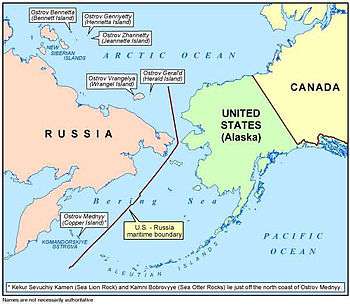USSR–USA Maritime Boundary Agreement

The Russia – United States maritime boundary de facto follows the June 1, 1990 USA/USSR Maritime Boundary Agreement [1] (since Russia declared itself to be the successor of the Soviet Union),[2] but it has yet to be approved by the Russian parliament. The United States Senate gave its advice and consent to ratification as early as on September 16, 1991, and has no intentions to reopen the issue.[2] In its turn, the US–USSR agreement is the confirmation of the earlier United States – Russia Convention of March 18 (O.S.)/March 30 (N.S.), 1867.[1] This sea border is also known as the Baker-Shevardnadze line or Baker-Shevardnadze agreement, after the officials who signed the deal, the Soviet foreign minister Eduard Shevardnadze and the US Secretary of State James Baker.[3]
From the point, 65° 30' N, 168° 58' 37" W the maritime boundary extends north along the 168° 58' 37" W meridian through the Bering Strait and Chukchi Sea into the Arctic Ocean as far as permitted under international law. From the same point southwards, the boundary follows a line specified by maritimegeographic positions given in the Agreement.[1]
Dispute
The need for the maritime boundary arose after the United States purchased Alaska from the Russian Empire. At the time, national maritime interests were restricted only to the three-mile limit. The purchase treaty did mention a boundary across the Bering Sea; however, with the introduction of the 200-mile limit by the Law of the Sea, the border issue became pressing, since neither side could produce the maps used during the original purchase negotiations. Furthermore, the two sides agreed that the boundary was intended to be a straight line on a map, but they did not agree which map projection was used: Mercator or conformal. This resulted in about 15,000 square nautical miles of disputed area. The 1990 line split the difference between the two lines and introduced several "special areas", which were beyond the 200-mile zone, but in which the sides ceded their rights to the opponent. The larger portion of the disputed area in the Bering Sea was agreed to belong to the United States; the United States Congress quickly ratified the agreement, but the Soviet Union failed to ratify the agreement before its collapse in 1991. Many in Russia have criticized Mikhail Gorbachev and Edvard Shevardnadze for rushing the deal, ceding the Russian fishing rights and other maritime benefits, and insist on renegotiation. The United States continues efforts to enforce the boundary line against the encroaching Russian fishing vessels, in order to build up the evidence of "general state practice" that the 1990 agreement is indeed the marine border between the two countries.[4]
References
- 1 2 3 1990 USSR/USA Maritime Boundary Agreement
- 1 2 Status of Wrangel and Other Arctic Islands
- ↑ "European press review", September 4, 2002, BBC News (retrieved Sep. 29, 2009)
- ↑ "US-Russian Bering Sea Marine Border Dispute: Conflict over Strategic Assets, Fisheries and Energy Resources", by Vlad M. Kaczynski, Warsaw School of Economics, "Maritime Border Conflicts", Russian Analytical Digest, no.20, 1 May 2007
Coordinates: 65°30′00″N 168°58′37″W / 65.50000°N 168.97694°W